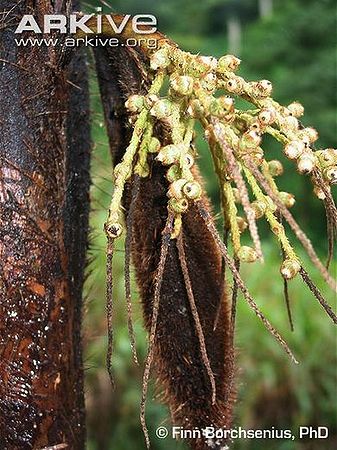Bactris setiflora
| Bactris (BAHK-triss) setiflora (seh-tih-FLOHR-ah) | |||||||
|---|---|---|---|---|---|---|---|
 Habitat. Photo by Dr. Finn Borchsenius. | |||||||
| Scientific Classification | |||||||
| |||||||
| Synonyms | |||||||
|
| |||||||
| Native Continent | |||||||
|
| |||||||
| Morphology | |||||||
| |||||||
| Culture | |||||||
|
| |||||||
| Survivability index | |||||||
|
| |||||||
| Common names | |||||||
|
| |||||||
Contents
Habitat and Distribution
Ecuador (Pastaza) montane forest at 770-1100 m elevation.
Description
Stems cespitose, forming large clumps of 5-30 stems, 2.9-5 m tall, 2-5 cm in diam., densely spiny on internodes. Leaves 3-6 per crown; leaf spines scattered, flattened, yellowish brown, tomentose and spinulose, to 8 cm long, on sheath and lateral surfaces of petiole, few or absent on rachis; sheath 40-71 cm long, sheath, petiole, and rachis densely brown-tomentose; ocrea prominent, spiny, tomentose, 14-25 cm long; petiole 20-33 cm long; rachis 1.1-1.8 m long; pinnae 25-34 per side, regularly arranged, spreading in the same plane, linear-lanceolate to sigmoid, spinulose abaxially and on veins adaxially; middle pinnae 48-66 x 3-4 cm. Inflorescences interfoliar; peduncle 18-20 cm long, recurved, spinulose; prophyll 20-32 cm long; peduncular bract 35-49 cm long, densely covered with yellowish brown or dark brown spines to 2 cm long; rachis 3-5 cm long; rachillae 11-23, 8-15 cm long, at anthesis densely covered with spinules; triads irregularly arranged among paired or solitary staminate flowers; staminate flowers not seen; pistillate flowers (post-anthesis) to 6 mm long; calyx cupular, to 3 mm long, spinulose; corolla urceolate, to 4 mm long, densely spinulose; staminodes not seen; fruits 2- 3 x 2-3 cm, obovoid, lilac; mesocarp juicy; endocarp obovoid, the sterile pores displaced longitudinally; endocarp fibers numerous, with juice sacs attached; fruiting perianth with lobed, 4 mm long, spinulose calyx and lobed, 8 mm long, spinulose corolla, without staminodial ring. (Henderson, A.J., Bactris (Palmae) in Flora Neotropica Monographs 79. 2000)/Palmweb. Editing by edric.
Bactris setiflora is diagnosed by its flattened, yellowish brown leaf spines, regularly arranged pinnae, spinulose abaxial leaf surface, and spinulose calyx and corolla of pistillate flowers. Borchsenius et al. (1998) report possible hybrids between this species and B. corossilla . The following seems to be an example: Ecuador. Pastaza: Puyo-Macas rd km 15, 10°28'S, 77°55'W, 940 m, 1 Apr 1992, Borgtoft Pedersen 97669 (AAU). (Henderson, A.J., Bactris (Palmae) in Flora Neotropica Monographs 79. 2000)/Palmweb.
Culture
Comments and Curiosities
Conservation: Endangered. (IUCN Red List)
Uses: The soft or liquid endosperm is eaten as a snack. Fruits are eaten, and the stem is used as a punt pole in canoes.
- IMAGE GALLERY
External Links
References
Phonetic spelling of Latin names by edric.
Special thanks to Geoff Stein, (Palmbob) for his hundreds of photos.
Special thanks to Palmweb.org, Dr. John Dransfield, Dr. Bill Baker & team, for their volumes of information and photos.
Glossary of Palm Terms; Based on the glossary in Dransfield, J., N.W. Uhl, C.B. Asmussen-Lange, W.J. Baker, M.M. Harley & C.E. Lewis. 2008. Genera Palmarum - Evolution and Classification of the Palms. Royal Botanic Gardens, Kew. All images copyright of the artists and photographers (see images for credits).
Henderson, A.J., Bactris (Palmae) in Flora Neotropica Monographs 79. 2000
Many Special Thanks to Ed Vaile for his long hours of tireless editing and numerous contributions.






